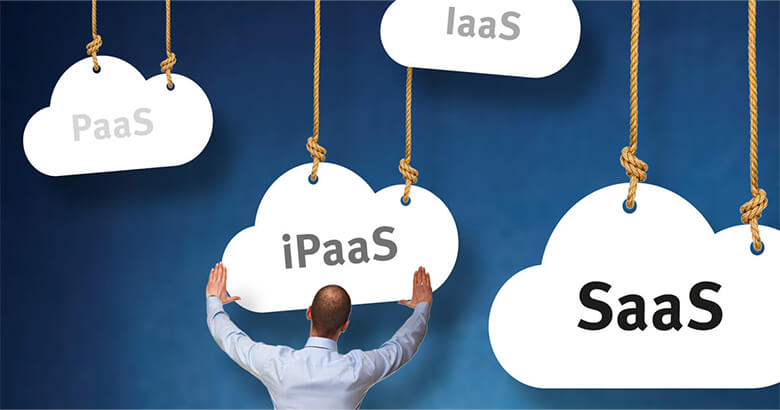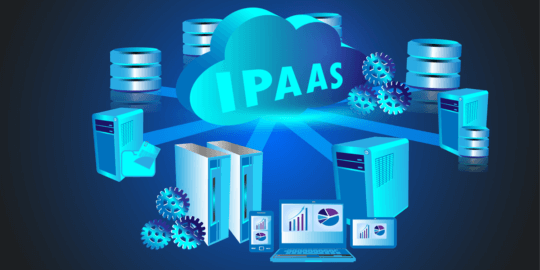Blog Series: 5 reasons iPaaS should be the heart of your cloud strategy

While digitalization is fuelled by cloud computing, there are challenges to public cloud migrations that hinder progress. The Hybrid Integration Platform (HIP) approach helps companies navigate the options and connect the on-premises and public cloud worlds to benefit the organization.
In a six-part blog series, you will learn why integration Platform as a Service (iPaaS) is an essential part of an intelligent cloud strategy. We’ll also answer questions like: What impact does iPaaS have on your business continuity management? How does iPaaS affect your application integration, multi-tenancy and scalability? What are the automation benefits of iPaaS and what happens to your existing systems? And, what is HIP?
Challenges of a good cloud strategy
Ongoing digital transformation poses great challenges for companies. Many technologies are new, for example, and there is a lack of experience among teams. Implementation can be fraught with risks and mistakes can be costly.
Public cloud computing – a fundamental part of digitalization – is becoming increasingly popular because of reduced costs and increased agility. It can also improve a company’s competitiveness for multiple reasons.
Therefore, a good cloud strategy is becoming more and more important for companies to survive against the competition. At the same time, it is becoming increasingly difficult to transfer all tasks to the public cloud, because:
- The cost of migrating existing systems are perceived as (still) too high; in addition
- There are security concerns or legal regulations prohibiting public cloud usage
- The IT landscape is complex because of highly individualized business processes
In addition, the public cloud, despite its many advantages, presents companies with some new challenges. Cloud solutions must be technically and strategically integrated with each other and with existing systems. Unfortunately, there is not always enough qualified personnel available to conduct the integrations.
Solution: hybrid integration platforms
The concept of the hybrid integration platform (HIP) can help to overcome these and other challenges. It allows you to maintain proven on-premises infrastructures while opening up to cloud applications and services where appropriate. For example, business users and integration specialists can work closely together to find a customized solution step by step. This takes into account how data, processes and applications can be integrated with each other and includes all possible endpoints such as on-premises, cloud, mobile devices and IoT technologies. The integration can be done via iPaaS, ESB, ETL, EDI, Point-to-Point, Internet and B2B gateways. APIs are also increasingly being used to access and deliver services. A well designed and professional API management is essential in this context.
Hybrid integration platform: iPaaS is a central component
The technologies, processes and competencies described above can either be provided by the company itself or one or more suppliers.
What is actually used depends on the individual needs of the company. However, one central point that will (almost) always be involved is an iPaaS solution. A relatively new technology trend, iPaaS has benefits many companies across the globe are not yet using to their advantage.
The basic idea is simple:
The integration platforms that have long existed in the world of business, such as CRM and ERP connectors, are being moved to the cloud and supplemented with connectors for integration with cloud services.
Instead of local servers and data synchronization between enterprise applications, iPaaS integrations enable users to host their connections in the cloud, where they are deployed and maintained by an external iPaaS provider and can be accessed via an Internet application.
iPaaS can therefore help ensure that a company’s myriad of services, whether in the cloud or on-premises, work together on a technically seamless and easily scalable basis. But a successful, long-term integration strategy involves more than just technology.

The dilemma of corporate IT and the way out
Over the past years, individual departments within organizations have been independently driving many cloud-based integration processes. This is because there is an increasing number of available SaaS solutions that address specific problems of business departments. In addition, they are relatively simple to manage, and there is easy access to development and administration resources for these solutions.
However, this only applies to simpler integration projects. If the technical complexity reaches a certain depth, as can quickly happen in the B2B integration environment, the IT department and experienced specialists have to get involved. At the same time, companies are faced with limited IT budgets and a shrinking pool of skilled workers.
One way to avoid this dilemma is offered by providers of hybrid integration approaches, who, in addition to technology, also provide expert personnel. These experts advise companies, suggest best practices for specific use cases, help with temporary manpower shortages, and help with complicated integration tasks. If desired, the experts can even take over the operation of the cloud-based integration platform completely, leaving the customer with only monitoring access to the platform.
SEEBURGER, for example, provides companies with an iPaaS solution based on the proven SEEBURGER Business Integration Suite (BIS), and expert personnel if needed.
Find out more about the different operating models of the SEEBURGER Business Integration Suite.
Thank you for your message
We appreciate your interest in SEEBURGER
Get in contact with us:
Please enter details about your project in the message section so we can direct your inquiry to the right consultant.
Written by: Holger Fiederling
Holger Fiederling has been working for SEEBURGER since 2008 and initially worked as a product manager for SEEBURGER B2B-Solutions. Since 2014, he has been responsible for pre-sales and business development for the SEEBURGER Cloud. His focus is on the creation of new, innovative solutions and services, which are oriented towards the requirements of the customers, always with the aim of maximizing the latest opportunities for the customers. In doing so, he attaches great importance to taking into account the experience gained from all of his international customer projects. After starting his career in the automotive industry, Holger Fiederling worked for two large management consultancies in the SAP environment and in the area of hosting and outsourcing of IT processes. To compensate for this, he spends a lot of time on his mountain bike or skiing in winter.





